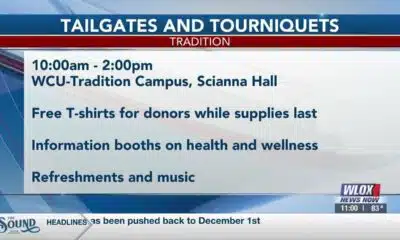Kaiser Health News
California’s Medicaid Experiment Spends Money to Save Money — And Help the Homeless
by Angela Hart
Wed, 19 Apr 2023 09:00:00 +0000
SAN DIEGO — Sporting a bright smile and the polished Super Bowl ring he won as a star NFL player in the late 1980s, Craig McEwen doesn’t fit the archetype of someone teetering on the brink of homelessness.
Evicted from his San Diego County apartment last July, McEwen — who endured repeated concussions during his six seasons in the NFL — scoured housing listings for anything he could afford.
Working as a part-time groundskeeper at a golf course for $15 an hour, his frantic search turned up nothing. So, feeling overwhelmed by rents pushing $3,000 a month for a one-bedroom apartment, he made a plan: move into his truck or rent a storage container to live in — an alternative he turned to when he was previously homeless in 2004.
McEwen is hopeful that a massive health care initiative in California offering new, specialized social services will help him get back on his feet. He is one of nearly 145,000 low-income Californians enrolled in CalAIM, an endeavor Gavin Newsom, the state’s Democratic governor, is spearheading to transform its Medicaid program, called Medi-Cal, into a new kind of safety net that provides housing and other services for people who are homeless or at risk of becoming homeless and have complicating conditions like mental illness or chronic disease that can make it difficult to manage life.
California launched the initiative in early 2022, rolling it out quietly, with health insurers and community groups scrambling to provide social services and benefits that fall outside traditional health care. It’s a five-year, $12 billion social experiment that Newsom is betting will eventually cut soaring health care spending in Medi-Cal, the largest Medicaid program in the country with 15.5 million enrollees.
The state is contracting the work to its 23 Medi-Cal managed-care health insurance companies. They are responsible for delivering a slew of new benefits to the most vulnerable enrollees: not only those with housing insecurity, but also people with mental health or addictive disorders; formerly incarcerated people transitioning back to society; seniors and people with disabilities; children in foster care; and Californians who frequent hospital emergency rooms or are admitted often to short-term skilled nursing facilities.
While only a sliver of the state’s Medi-Cal patients are enrolled in CalAIM, tens of thousands of low-income Californians could qualify for the new benefits. They’re eligible for help in finding housing and for paying rental move-in costs like security deposits.
But the help goes beyond housing. The state is also providing the most at-risk patients with intensive case management, alongside pioneering social services — such as healthy home-delivered meals for diabetes patients and mold removal in homes of patients with severe asthma.
Top state health officials say that with such an ambitious program — using Medicaid to help solve homelessness and combat chronic disease — they expected the rollout to be bumpy. After 2026, when the initiative’s funding ends, the state plans to prove the experiment works and permanently adopt the benefits. Meanwhile, other states are closely watching California, hoping to learn from its successes and failures.
“California is a leader, and it’s always experimenting in new and interesting ways,” said Dr. Georges Benjamin, executive director of the American Public Health Association. “What it can do is provide proof of concept, and then this can grow to other states.”
Insurers, in essence, are building a new health care workforce, contracting with nonprofit and for-profit organizations to enroll the most vulnerable — and expensive — Medi-Cal patients. They’re hiring social workers and case managers to find those who rack up extreme health care costs in hospital emergency rooms, nursing homes, prisons, jails, and mental health crisis centers.
As Newsom sees it, the immense investment will pay off for taxpayers. Targeting people cycling in and out of costly institutions will reduce health care spending, he argues, while also helping people get healthy. State health officials say 5% of high-need Medi-Cal patients account for roughly half of all health care spending in the low-income health care program.
The most important currency in pulling off this massive health care experiment is trust. And that is being built on the ground, with community outreach workers scouring hospitals and homeless encampments, for example, to find those eligible for CalAIM.
The most at-risk Medi-Cal patients are being linked to specialized teams deployed under a new entitlement benefit at the heart of the initiative called “enhanced care management.” While other services like covering security deposits are optional, this is not. Health insurers are required to accept people who are most in need and provide a wide range of health and social services.
It can be simple things like arranging an Uber to get to a medical appointment or buying a computer for an enrollee looking for a job. Or purchasing a bike for a low-income kid. But it also involves intensive, one-on-one work that can require case managers to take patients to get an identification card, make nighttime phone calls to ensure patients are taking medications, and hunt down available apartments.
“This is the missing piece, and it’s the hardest work — the most costly work,” Newsom said in an interview with KFF Health News. “People on the streets and sidewalks, they’ve lost trust. They’ve become socially isolated. They’ve lost connection, and so developing that is so foundational.”
‘My Own Prison’
McEwen, who was a tight end for the NFL team now known as the Washington Commanders and later for the San Diego Chargers, was hailed as a “legacy.” But playing professional football took an extreme toll.
“My position was to block for the quarterback, and back in the day, you were allowed to hit people in the head,” McEwen said, recalling regular concussions on the field that he’d snap himself out of by sniffing ammonia packets. He helped lead the Washington team to a Super Bowl victory in 1987, but in the decades since, his health has deteriorated.
McEwen has struggled for years to find regular work while dealing with thoughts of suicide, anger, forgetfulness, and depression that he says stem from traumatic brain injuries sustained during his football career. At 57, he endures continual pain from ruptured disks in his neck and spine, along with shortness of breath from severe heart disease.
He’d holed up in his apartment for years, with curtains nailed to his windows, drowning his pain with alcohol. “I basically created my own prison,” he said.
After he was evicted last July, a longtime friend swooped in to let him stay temporarily in a spare bedroom at his family’s house just outside San Diego. But McEwen’s financial and emotional struggle to find stable housing hasn’t ended.
“We don’t call it fear. Us ballplayers, we call it excitement,” McEwen said on a rainy morning in early March, his eyes swelling with tears. “I’m excited. I know what’s at stake. My life is at stake.”
Housing instability is just one part of it. He’d often forget to take his medications for high cholesterol and clogged arteries. He felt paralyzing anxiety and his brain was so scrambled he’d miss important doctor appointments — a side effect, he said, of the concussions.
McEwen knew he needed help.
He’d learned from a friend that California was helping Medi-Cal patients with not just medical needs but also social services, and he started making calls, insisting on getting in. “I said wait, you’re giving people a coach? Someone who can make appointments for me and go to my doctor visits with me?”
Weeks after receiving his eviction notice, his Medi-Cal insurer, Molina Healthcare, connected him with a personal care manager, whom McEwen calls “my advocate, someone who can teach me how to do for myself and give myself a life worth living.”
But who gets in the program is often a roll of the dice, depending largely on which Medi-Cal insurance company a person is enrolled in. Persistence plays a big role.
Despite early glimmers of hope, the rollout has been chaotic. Providers on the ground scramble to find any available housing for enrollees. Groups implementing the initiative say inadequate funding and dire health workforce shortages have severely constrained their ability to serve all those in need. And enrollment by health insurers is uneven, with some quickly approving new benefits for their members while others are denied. Some insurers provide on-the-spot Uber rides for doctor appointments while others offer only a bus pass.
“What is being offered is insufficient, and this program is not set up to support those who are actually the most vulnerable and need the most intensive support,” said Nancy Behm, associate director of CalAIM for a San Diego nonprofit called People Assisting the Homeless, or PATH.
Operating under contracts with Blue Shield of California, Molina Healthcare, and Health Net, PATH launched intensive case management and housing services in January 2022. But it has since stopped providing intensive case management benefits largely due to a lack of sufficient funding to do the grueling work of connecting with homeless people living in encampments. “We’re hitting barriers on every front,” Behm said.
Newsom, with his soaring political ambitions, is promising to help the most vulnerable Californians. Termed out in 2026, speculation is mounting that the two-term governor is eyeing a presidential run, and he’s using health care as a core issue to elevate his national profile. In reality, his Medi-Cal initiative is falling far short.
“This is an extremely ambitious program, but it doesn’t come close to helping the entirety of the population it’s targeting,” said Doug Herman, who worked for former President Barack Obama and former Los Angeles Mayor Eric Garcetti. “This isn’t a policy solution big enough to really make a dent in homelessness.”
No Walk in the Park
On a brisk morning in late February, Jeannine Nash pulled into the drive-thru of a Jack in the Box in Chula Vista, just south of San Diego. She dug in her wallet to find $8.17 for 10 breakfast sandwiches to hand out to homeless people on her regular rounds visiting encampments.
“It helps me to come out here before work, to get an idea of what the needs are,” Nash said as she approached a nearby homeless woman slumped over on a sidewalk who had nothing with her but a brand-new walker and hospital discharge paperwork tucked in a plastic bag.
Nash is director of referrals for Serene Health, a for-profit health care company that is one of nearly 500 provider organizations being paid to link homeless people or those at risk with intensive case management, housing, and other services.
A recovering addict herself, Nash said her life experience has helped her connect with people living outside and struggling with substance use disorders. She figures out how to get those who appear resistant to accept services. “So many people are distrustful of authority,” said Nash, who has a son who is homeless.
“This is very, very dear to my heart,” Nash said. In her decades since becoming sober, she has gained deep experience getting the people most at risk of spiraling deeper into crisis into treatment beds and even apartments. She’s cultivated relationships with housing and nursing home agencies so she can quickly identify openings.
But her job comes with extraordinary challenges. She often has to level with people living outside, telling them there is simply nowhere for them to go. “There’s just not enough beds or housing out there,” she said. “And if you don’t have an income, it’s not going to happen.”
Nash handed the homeless woman in the doorway two sandwiches, coaxing her to eat. The woman, Christina Gallegos, 38, was suffering from extreme liver damage due to chronic drinking and had crawled the few blocks from Scripps Mercy Hospital in Chula Vista, where she was discharged the night before.
She had been in the emergency room, her hospital discharge paperwork showed — one of several ER trips she’d made in the past month. She was given the walker but couldn’t walk and dragged it into a doorway for shelter.
“We see this all the time. It’s getting really bad,” Nash said, texting her contacts to find a bed for Gallegos. “She’s definitely eligible. It’s just finding somewhere for her to go that is going to be hard.”
Gallegos has Medi-Cal but hasn’t been enrolled in the new benefits California is offering. She was among an estimated 8,500 homeless people identified in San Diego County in 2022, a 10% increase since 2020.
San Diego County is massive and populous, and while homeless encampments permeate suburban enclaves like Chula Vista, homeless people are largely clustered in San Diego’s downtown neighborhood and its parks.
One popular place to pitch a tent is Balboa Park near the San Diego Zoo. Its canyons and sprawling green lawns are peppered with tent communities, whose inhabitants plead for help from community groups. Many hang on to business cards from homeless outreach workers in hopes of scoring a shelter bed or permanent housing. While some people do get housing, many feel as if outreach efforts amount to broken promises.
One man, David Lloyd, pulled from his pocket a phone number for an outreach worker from the homeless services provider PATH, who told him that he was on a waiting list for housing but that he could be waiting in the queue for years.
“It’s a big list,” said Lloyd, 66. “I just want to get off the streets. I’m tired of the cops harassing me all the time.”
Cally Wood, 35, said she is addicted to fentanyl and has been on the waiting list for housing for more than a year. “It just feels really impossible,” she said. “There’s nothing affordable.”
Health insurance executives, including Martha Santana-Chin, Medi-Cal president for Health Net in California, said Medi-Cal managed-care plans are making progress in helping get people off the streets and into services. Yet she acknowledged the initial rollout falls short.
“We just don’t have the housing supply that we need,” Santana-Chin said, “to be confident that all of these folks who need support and services are going to get permanently placed.”
Hampered by Sweeps
Across the region, sweeps of homeless encampments are common and becoming part of everyday life for people living outside. Deteriorating and unsanitary conditions on the streets fuel public frustration.
Newsom has ratcheted up the practice of clearing encampments, arguing that people dealing with homelessness should not be allowed to live outdoors, despite a dearth of alternatives. He’s allocating state funding to cities and counties to remove tents from streets and sidewalks and move people into any shelter or housing available. San Diego Mayor Todd Gloria, also a Democrat, is unapologetic about adopting the approach.
“We’re doing the cleanups that are necessary for public safety,” Gloria told KFF Health News. “These conditions are unsanitary, and it puts people’s health and safety at risk, and it leads to people dying. Some people disagree with me under the guise of caring for these individuals, but the sidewalk is not a home.”
Outreach workers on the ground, however, say the enforcement crackdown only makes their jobs harder. One of the most critical goals of the new Medi-Cal initiative is to regularly visit people on the streets, build relationships with them, and help them with health care needs, all while preparing them for housing — if it becomes available.
“This really takes a lot of time. Sometimes you start with just bringing someone socks or a bottle of water. It can take 70 encounters for someone to accept our help,” said Andrea Karrer, an outreach worker with PATH. “But that time is what allows you to build trust with someone, and when they have to constantly move, you have to find that person, and sometimes start all over.”
And the disruptions ultimately cause people without housing to get sicker and visit the ER more often, she and other outreach workers said.
“When you have to move every two or three days, getting to the doctor or staying on medication is not the biggest priority. You’re in survival mode,” Karrer said.
A Labor-Intensive Effort
Serene Health is one of hundreds of providers enrolling Medi-Cal patients into intensive case management. Together, they have signed up 108,000 patients statewide so far, according to California’s Department of Health Care Services, which administers Medi-Cal. An additional 28,000 are receiving the new housing services such as security deposit payments and help identifying affordable housing.
“A lot of the stuff we’re doing is just really new to health care,” said Jacey Cooper, the state’s Medicaid director. She said that health insurers are offering housing services in all 58 counties, yet she acknowledged that the need exceeds capacity.
“It takes time for that infrastructure to come to fruition,” Cooper said of the challenge of identifying housing for Medi-Cal patients who frequent hospital ERs. “We are in a massive education moment of even making sure people understand who’s eligible and how to refer, and educating the entire delivery system, from hospitals to providers.”
Meanwhile, Newsom is asking the Biden administration for permission to add another housing benefit that would cover up to six months of direct rent payments.
Veronica Ortiz, a lead care manager for Serene Health, has Craig McEwen on her roster of about 60 patients — a large caseload that is difficult to manage.
But Ortiz bubbles with compassion and energy and said working with patients like McEwen has given her even more drive to make a difference. The work is arduous, but McEwen is quickly becoming more independent, she said.
“When we come into their lives, we’re strangers, so we have to spend a lot of time meeting face-to-face with people and helping with anything they need, otherwise they’re not going to trust us.”
But help didn’t come fast enough for Donna Fontenot, a San Diego County resident who is being evicted from her apartment this month. Her landlord told her she had to leave following repeated ER trips, hospitalizations, and skilled nursing home stays stemming from an initial fall in 2022 that left her in a wheelchair.
“I’m petrified and absolutely panicking, I have nowhere to go,” Fontenot said. With one hospitalization alone costing an average of $18,000 in California, Fontenot, who is on Medi-Cal, has racked up high health care costs.
She has been hospitalized eight times since March 2022, she said. And on five occasions, her injuries to her feet and legs were so extreme that she needed placement in a nursing home.
Yet her Medi-Cal insurer, the San Diego-based Community Health Group, instituted a rule that to qualify for some housing services, she must have a child under 18. So she isn’t receiving housing assistance that could help her. She is, however, enrolled in intensive case management. But she was not aware of that until KFF Health News informed her.
“I feel like I won the lottery,” she said. “Is it going to help me?”
Her care manager hasn’t been as involved in her life as Ortiz has been with McEwen. Fontenot continues to search on her own for housing, and recently asked to be switched into Serene Health to get more hands-on assistance. “I’ve never needed help like this before. I feel so broken,” she said in tears. “Where am I going to go?”
Today, Ortiz is helping McEwen search for housing. She also has focused on helping him get his heart condition under control and find more stable work.
In March, he landed a job as a security guard patrolling sporting events, including at football stadiums. And he scored a hard-to-get surgery appointment for late this month to help unclog the arteries in his heart.
“Before Veronica, I was waiting to die. I was eating and drinking to die. But she showed up for me. Somebody cared about me. And that gave me the courage to share with her what my dream would be,” McEwen said. “I thought I needed football to be loved — then I’d be worth it.
“But I know now that my true purpose is to be of service and to be there for my daughter. I decided to get back on the field, instead of sitting on the sidelines.”
This article was produced by KFF Health News, which publishes California Healthline, an editorially independent service of the California Health Care Foundation.
KFF Health News is a national newsroom that produces in-depth journalism about health issues and is one of the core operating programs at KFF—an independent source of health policy research, polling, and journalism. Learn more about KFF.
USE OUR CONTENT
This story can be republished for free (details).
By: Angela Hart
Title: California’s Medicaid Experiment Spends Money to Save Money — And Help the Homeless
Sourced From: kffhealthnews.org/news/article/california-homelessness-calaim-program-medicaid-experiment/
Published Date: Wed, 19 Apr 2023 09:00:00 +0000
Kaiser Health News
How To Find the Right Medical Rehab Services
Rehabilitation therapy can be a godsend after hospitalization for a stroke, a fall, an accident, a joint replacement, a severe burn, or a spinal cord injury, among other conditions. Physical, occupational, and speech therapy are offered in a variety of settings, including at hospitals, nursing homes, clinics, and at home. It’s crucial to identify a high-quality, safe option with professionals experienced in treating your condition.
What kinds of rehab therapy might I need?
Physical therapy helps patients improve their strength, stability, and movement and reduce pain, usually through targeted exercises. Some physical therapists specialize in neurological, cardiovascular, or orthopedic issues. There are also geriatric and pediatric specialists. Occupational therapy focuses on specific activities (referred to as “occupations”), often ones that require fine motor skills, like brushing teeth, cutting food with a knife, and getting dressed. Speech and language therapy help people communicate. Some patients may need respiratory therapy if they have trouble breathing or need to be weaned from a ventilator.
Will insurance cover rehab?
Medicare, health insurers, workers’ compensation, and Medicaid plans in some states cover rehab therapy, but plans may refuse to pay for certain settings and may limit the amount of therapy you receive. Some insurers may require preauthorization, and some may terminate coverage if you’re not improving. Private insurers often place annual limits on outpatient therapy. Traditional Medicare is generally the least restrictive, while private Medicare Advantage plans may monitor progress closely and limit where patients can obtain therapy.
Should I seek inpatient rehabilitation?
Patients who still need nursing or a doctor’s care but can tolerate three hours of therapy five days a week may qualify for admission to a specialized rehab hospital or to a unit within a general hospital. Patients usually need at least two of the main types of rehab therapy: physical, occupational, or speech. Stays average around 12 days.
How do I choose?
Look for a place that is skilled in treating people with your diagnosis; many inpatient hospitals list specialties on their websites. People with complex or severe medical conditions may want a rehab hospital connected to an academic medical center at the vanguard of new treatments, even if it’s a plane ride away.
“You’ll see youngish patients with these life-changing, fairly catastrophic injuries,” like spinal cord damage, travel to another state for treatment, said Cheri Blauwet, chief medical officer of Spaulding Rehabilitation in Boston, one of 15 hospitals the federal government has praised for cutting-edge work.
But there are advantages in selecting a hospital close to family and friends who can help after you are discharged. Therapists can help train at-home caregivers.
How do I find rehab hospitals?
The discharge planner or caseworker at the acute care hospital should provide options. You can search for inpatient rehabilitation facilities by location or name through Medicare’s Care Compare website. There you can see how many patients the rehab hospital has treated with your condition — the more the better. You can search by specialty through the American Medical Rehabilitation Providers Association, a trade group that lists its members.
Find out what specialized technologies a hospital has, like driving simulators — a car or truck that enable a patient to practice getting in and out of a vehicle — or a kitchen table with utensils to practice making a meal.
How can I be confident a rehab hospital is reliable?
It’s not easy: Medicare doesn’t analyze staffing levels or post on its website results of safety inspections as it does for nursing homes. You can ask your state public health agency or the hospital to provide inspection reports for the last three years. Such reports can be technical, but you should get the gist. If the report says an “immediate jeopardy” was called, that means inspectors identified safety problems that put patients in danger.
The rate of patients readmitted to a general hospital for a potentially preventable reason is a key safety measure. Overall, for-profit rehabs have higher readmission rates than nonprofits do, but there are some with lower readmission rates and some with higher ones. You may not have a nearby choice: There are fewer than 400 rehab hospitals, and most general hospitals don’t have a rehab unit.
You can find a hospital’s readmission rates under Care Compare’s quality section. Rates lower than the national average are better.
Another measure of quality is how often patients are functional enough to go home after finishing rehab rather than to a nursing home, hospital, or health care institution. That measure is called “discharge to community” and is listed under Care Compare’s quality section. Rates higher than the national average are better.
Look for reviews of the hospital on Yelp and other sites. Ask if the patient will see the same therapist most days or a rotating cast of characters. Ask if the therapists have board certifications earned after intensive training to treat a patient’s particular condition.
Visit if possible, and don’t look only at the rooms in the hospital where therapy exercises take place. Injuries often occur in the 21 hours when a patient is not in therapy, but in his or her room or another part of the building. Infections, falls, bedsores, and medication errors are risks. If possible, observe whether nurses promptly respond to call lights, seem overloaded with too many patients, or are apathetically playing on their phones. Ask current patients and their family members if they are satisfied with the care.
What if I can’t handle three hours of therapy a day?
A nursing home that provides rehab might be appropriate for patients who don’t need the supervision of a doctor but aren’t ready to go home. The facilities generally provide round-the-clock nursing care. The amount of rehab varies based on the patient. There are more than 14,500 skilled nursing facilities in the United States, 12 times as many as hospitals offering rehab, so a nursing home may be the only option near you.
You can look for them through Medicare’s Care Compare website. (Read our previous guide to finding a good, well-staffed home to know how to assess the overall staffing.)
What if patients are too frail even for a nursing home?
They might need a long-term care hospital. Those specialize in patients who are in comas, on ventilators, and have acute medical conditions that require the presence of a physician. Patients stay at least four weeks, and some are there for months. Care Compare helps you search. There are fewer than 350 such hospitals.
I’m strong enough to go home. How do I receive therapy?
Many rehab hospitals offer outpatient therapy. You also can go to a clinic, or a therapist can come to you. You can hire a home health agency or find a therapist who takes your insurance and makes house calls. Your doctor or hospital may give you referrals. On Care Compare, home health agencies list whether they offer physical, occupational, or speech therapy. You can search for board-certified therapists on the American Physical Therapy Association’s website.
While undergoing rehab, patients sometimes move from hospital to nursing facility to home, often at the insistence of their insurers. Alice Bell, a senior specialist at the APTA, said patients should try to limit the number of transitions, for their own safety.
“Every time a patient moves from one setting to another,” she said, “they’re in a higher risk zone.”
KFF Health News is a national newsroom that produces in-depth journalism about health issues and is one of the core operating programs at KFF—an independent source of health policy research, polling, and journalism. Learn more about KFF.
USE OUR CONTENT
This story can be republished for free (details).
KFF Health News is a national newsroom that produces in-depth journalism about health issues and is one of the core operating programs at KFF—an independent source of health policy research, polling, and journalism. Learn more about KFF.
Subscribe to KFF Health News’ free Morning Briefing.
This article first appeared on KFF Health News and is republished here under a Creative Commons license.
The post How To Find the Right Medical Rehab Services appeared first on kffhealthnews.org
Note: The following A.I. based commentary is not part of the original article, reproduced above, but is offered in the hopes that it will promote greater media literacy and critical thinking, by making any potential bias more visible to the reader –Staff Editor.
Political Bias Rating: Centrist
This article from KFF Health News provides a comprehensive, fact-based guide to rehabilitation therapy options and how to navigate insurance, care settings, and provider quality. It avoids ideological framing and presents information in a neutral, practical tone aimed at helping consumers make informed medical decisions. While it touches on Medicare and private insurance policies, it does so without political commentary or value judgments, and no partisan viewpoints or advocacy positions are evident. The focus remains on patient care, safety, and informed choice, supporting a nonpartisan, service-oriented approach to health reporting.
Kaiser Health News
States Brace for Reversal of Obamacare Coverage Gains Under Trump’s Budget Bill
Shorter enrollment periods. More paperwork. Higher premiums. The sweeping tax and spending bill pushed by President Donald Trump includes provisions that would not only reshape people’s experience with the Affordable Care Act but, according to some policy analysts, also sharply undermine the gains in health insurance coverage associated with it.
The moves affect consumers and have particular resonance for the 19 states (plus Washington, D.C.) that run their own ACA exchanges.
Many of those states fear that the additional red tape — especially requirements that would end automatic reenrollment — would have an outsize impact on their policyholders. That’s because a greater percentage of people in those states use those rollovers versus shopping around each year, which is more commonly done by people in states that use the federal healthcare.gov marketplace.
“The federal marketplace always had a message of, ‘Come back in and shop,’ while the state-based markets, on average, have a message of, ‘Hey, here’s what you’re going to have next year, here’s what it will cost; if you like it, you don’t have to do anything,’” said Ellen Montz, who oversaw the federal ACA marketplace under the Biden administration as deputy administrator and director at the Center for Consumer Information and Insurance Oversight. She is now a managing director with the Manatt Health consulting group.
Millions — perhaps up to half of enrollees in some states — may lose or drop coverage as a result of that and other changes in the legislation combined with a new rule from the Trump administration and the likely expiration at year’s end of enhanced premium subsidies put in place during the covid-19 pandemic. Without an extension of those subsidies, which have been an important driver of Obamacare enrollment in recent years, premiums are expected to rise 75% on average next year. That’s starting to happen already, based on some early state rate requests for next year, which are hitting double digits.
“We estimate a minimum 30% enrollment loss, and, in the worst-case scenario, a 50% loss,” said Devon Trolley, executive director of Pennie, the ACA marketplace in Pennsylvania, which had 496,661 enrollees this year, a record.
Drops of that magnitude nationally, coupled with the expected loss of Medicaid coverage for millions more people under the legislation Trump calls the “One Big Beautiful Bill,” could undo inroads made in the nation’s uninsured rate, which dropped by about half from the time most of the ACA’s provisions went into effect in 2014, when it hovered around 14% to 15% of the population, to just over 8%, according to the most recent data.
Premiums would rise along with the uninsured rate, because older or sicker policyholders are more likely to try to jump enrollment hurdles, while those who rarely use coverage — and are thus less expensive — would not.
After a dramatic all-night session, House Republicans passed the bill, meeting the president’s July 4 deadline. Trump is expected to sign the measure on Independence Day. It would increase the federal deficit by trillions of dollars and cut spending on a variety of programs, including Medicaid and nutrition assistance, to partly offset the cost of extending tax cuts put in place during the first Trump administration.
The administration and its supporters say the GOP-backed changes to the ACA are needed to combat fraud. Democrats and ACA supporters see this effort as the latest in a long history of Republican efforts to weaken or repeal Obamacare. Among other things, the legislation would end several changes put in place by the Biden administration that were credited with making it easier to sign up, such as lengthening the annual open enrollment period and launching a special program for very low-income people that essentially allows them to sign up year-round.
In addition, automatic reenrollment, used by more than 10 million people for 2025 ACA coverage, would end in the 2028 sign-up season. Instead, consumers would have to update their information, starting in August each year, before the close of open enrollment, which would end Dec. 15, a month earlier than currently.
That’s a key change to combat rising enrollment fraud, said Brian Blase, president of the conservative Paragon Health Institute, because it gets at what he calls the Biden era’s “lax verification requirements.”
He blames automatic reenrollment, coupled with the availability of zero-premium plans for people with lower incomes that qualify them for large subsidies, for a sharp uptick in complaints from insurers, consumers, and brokers about fraudulent enrollments in 2023 and 2024. Those complaints centered on consumers’ being enrolled in an ACA plan, or switched from one to another, without authorization, often by commission-seeking brokers.
In testimony to Congress on June 25, Blase wrote that “this simple step will close a massive loophole and significantly reduce improper enrollment and spending.”
States that run their own marketplaces, however, saw few, if any, such problems, which were confined mainly to the 31 states using the federal healthcare.gov.
The state-run marketplaces credit their additional security measures and tighter control over broker access than healthcare.gov for the relative lack of problems.
“If you look at California and the other states that have expanded their Medicaid programs, you don’t see that kind of fraud problem,” said Jessica Altman, executive director of Covered California, the state’s Obamacare marketplace. “I don’t have a single case of a consumer calling Covered California saying, ‘I was enrolled without consent.’”
Such rollovers are common with other forms of health insurance, such as job-based coverage.
“By requiring everyone to come back in and provide additional information, and the fact that they can’t get a tax credit until they take this step, it is essentially making marketplace coverage the most difficult coverage to enroll in,” said Trolley at Pennie, 65% of whose policyholders were automatically reenrolled this year, according to KFF data. KFF is a health information nonprofit that includes KFF Health News.
Federal data shows about 22% of federal sign-ups in 2024 were automatic-reenrollments, versus 58% in state-based plans. Besides Pennsylvania, the states that saw such sign-ups for more than 60% of enrollees include California, New York, Georgia, New Jersey, and Virginia, according to KFF.
States do check income and other eligibility information for all enrollees — including those being automatically renewed, those signing up for the first time, and those enrolling outside the normal open enrollment period because they’ve experienced a loss of coverage or other life event or meet the rules for the low-income enrollment period.
“We have access to many data sources on the back end that we ping, to make sure nothing has changed. Most people sail through and are able to stay covered without taking any proactive step,” Altman said.
If flagged for mismatched data, applicants are asked for additional information. Under current law, “we have 90 days for them to have a tax credit while they submit paperwork,” Altman said.
That would change under the tax and spending plan before Congress, ending presumptive eligibility while a person submits the information.
A white paper written for Capital Policy Analytics, a Washington-based consultancy that specializes in economic analysis, concluded there appears to be little upside to the changes.
While “tighter verification can curb improper enrollments,” the additional paperwork, along with the expiration of higher premiums from the enhanced tax subsidies, “would push four to six million eligible people out of Marketplace plans, trading limited fraud savings for a surge in uninsurance,” wrote free market economists Ike Brannon and Anthony LoSasso.
“Insurers would be left with a smaller, sicker risk pool and heightened pricing uncertainty, making further premium increases and selective market exits [by insurers] likely,” they wrote.
KFF Health News is a national newsroom that produces in-depth journalism about health issues and is one of the core operating programs at KFF—an independent source of health policy research, polling, and journalism. Learn more about KFF.
USE OUR CONTENT
This story can be republished for free (details).
KFF Health News is a national newsroom that produces in-depth journalism about health issues and is one of the core operating programs at KFF—an independent source of health policy research, polling, and journalism. Learn more about KFF.
Subscribe to KFF Health News’ free Morning Briefing.
This article first appeared on KFF Health News and is republished here under a Creative Commons license.
The post States Brace for Reversal of Obamacare Coverage Gains Under Trump’s Budget Bill appeared first on kffhealthnews.org
Note: The following A.I. based commentary is not part of the original article, reproduced above, but is offered in the hopes that it will promote greater media literacy and critical thinking, by making any potential bias more visible to the reader –Staff Editor.
Political Bias Rating: Center-Left
This content presents a critique of Republican-led changes to the Affordable Care Act, emphasizing potential negative impacts such as increased premiums, reduced enrollment, and the erosion of coverage gains made under the ACA. It highlights the perspective of policy analysts and state officials who express concern over these measures, while also presenting conservative viewpoints, particularly those focusing on fraud reduction. Overall, the tone and framing lean toward protecting the ACA and its expansions, which traditionally aligns with Center-Left media analysis.
Kaiser Health News
Dual Threats From Trump and GOP Imperil Nursing Homes and Their Foreign-Born Workers
In a top-rated nursing home in Alexandria, Virginia, the Rev. Donald Goodness is cared for by nurses and aides from various parts of Africa. One of them, Jackline Conteh, a naturalized citizen and nurse assistant from Sierra Leone, bathes and helps dress him most days and vigilantly intercepts any meal headed his way that contains gluten, as Goodness has celiac disease.
“We are full of people who come from other countries,” Goodness, 92, said about Goodwin House Alexandria’s staff. Without them, the retired Episcopal priest said, “I would be, and my building would be, desolate.”
The long-term health care industry is facing a double whammy from President Donald Trump’s crackdown on immigrants and the GOP’s proposals to reduce Medicaid spending. The industry is highly dependent on foreign workers: More than 800,000 immigrants and naturalized citizens comprise 28% of direct care employees at home care agencies, nursing homes, assisted living facilities, and other long-term care companies.
But in January, the Trump administration rescinded former President Joe Biden’s 2021 policy that protected health care facilities from Immigration and Customs Enforcement raids. The administration’s broad immigration crackdown threatens to drastically reduce the number of current and future workers for the industry. “People may be here on a green card, and they are afraid ICE is going to show up,” said Katie Smith Sloan, president of LeadingAge, an association of nonprofits that care for older adults.
Existing staffing shortages and quality-of-care problems would be compounded by other policies pushed by Trump and the Republican-led Congress, according to nursing home officials, resident advocates, and academic experts. Federal spending cuts under negotiation may strip nursing homes of some of their largest revenue sources by limiting ways states leverage Medicaid money and making it harder for new nursing home residents to retroactively qualify for Medicaid. Care for 6 in 10 residents is paid for by Medicaid, the state-federal health program for poor or disabled Americans.
“We are facing the collision of two policies here that could further erode staffing in nursing homes and present health outcome challenges,” said Eric Roberts, an associate professor of internal medicine at the University of Pennsylvania.
The industry hasn’t recovered from covid-19, which killed more than 200,000 long-term care facility residents and workers and led to massive staff attrition and turnover. Nursing homes have struggled to replace licensed nurses, who can find better-paying jobs at hospitals and doctors’ offices, as well as nursing assistants, who can earn more working at big-box stores or fast-food joints. Quality issues that preceded the pandemic have expanded: The percentage of nursing homes that federal health inspectors cited for putting residents in jeopardy of immediate harm or death has risen alarmingly from 17% in 2015 to 28% in 2024.
In addition to seeking to reduce Medicaid spending, congressional Republicans have proposed shelving the biggest nursing home reform in decades: a Biden-era rule mandating minimum staffing levels that would require most of the nation’s nearly 15,000 nursing homes to hire more workers.
The long-term care industry expects demand for direct care workers to burgeon with an influx of aging baby boomers needing professional care. The Census Bureau has projected the number of people 65 and older would grow from 63 million this year to 82 million in 2050.
In an email, Vianca Rodriguez Feliciano, a spokesperson for the Department of Health and Human Services, said the agency “is committed to supporting a strong, stable long-term care workforce” and “continues to work with states and providers to ensure quality care for older adults and individuals with disabilities.” In a separate email, Tricia McLaughlin, a Department of Homeland Security spokesperson, said foreigners wanting to work as caregivers “need to do that by coming here the legal way” but did not address the effect on the long-term care workforce of deportations of classes of authorized immigrants.
Goodwin Living, a faith-based nonprofit, runs three retirement communities in northern Virginia for people who live independently, need a little assistance each day, have memory issues, or require the availability of around-the-clock nurses. It also operates a retirement community in Washington, D.C. Medicare rates Goodwin House Alexandria as one of the best-staffed nursing homes in the country. Forty percent of the organization’s 1,450 employees are foreign-born and are either seeking citizenship or are already naturalized, according to Lindsay Hutter, a Goodwin spokesperson.
“As an employer, we see they stay on with us, they have longer tenure, they are more committed to the organization,” said Rob Liebreich, Goodwin’s president and CEO.
Jackline Conteh spent much of her youth shuttling between Sierra Leone, Liberia, and Ghana to avoid wars and tribal conflicts. Her mother was killed by a stray bullet in her home country of Liberia, Conteh said. “She was sitting outside,” Conteh, 56, recalled in an interview.
Conteh was working as a nurse in a hospital in Sierra Leone in 2009 when she learned of a lottery for visas to come to the United States. She won, though she couldn’t afford to bring her husband and two children along at the time. After she got a nursing assistant certification, Goodwin hired her in 2012.
Conteh said taking care of elders is embedded in the culture of African families. When she was 9, she helped feed and dress her grandmother, a job that rotated among her and her sisters. She washed her father when he was dying of prostate cancer. Her husband joined her in the United States in 2017; she cares for him because he has heart failure.
“Nearly every one of us from Africa, we know how to care for older adults,” she said.
Her daughter is now in the United States, while her son is still in Africa. Conteh said she sends money to him, her mother-in-law, and one of her sisters.
In the nursing home where Goodness and 89 other residents live, Conteh helps with daily tasks like dressing and eating, checks residents’ skin for signs of swelling or sores, and tries to help them avoid falling or getting disoriented. Of 102 employees in the building, broken up into eight residential wings called “small houses” and a wing for memory care, at least 72 were born abroad, Hutter said.
Donald Goodness grew up in Rochester, New York, and spent 25 years as rector of The Church of the Ascension in New York City, retiring in 1997. He and his late wife moved to Alexandria to be closer to their daughter, and in 2011 they moved into independent living at the Goodwin House. In 2023 he moved into one of the skilled nursing small houses, where Conteh started caring for him.
“I have a bad leg and I can’t stand on it very much, or I’d fall over,” he said. “She’s in there at 7:30 in the morning, and she helps me bathe.” Goodness said Conteh is exacting about cleanliness and will tell the housekeepers if his room is not kept properly.
Conteh said Goodness was withdrawn when he first arrived. “He don’t want to come out, he want to eat in his room,” she said. “He don’t want to be with the other people in the dining room, so I start making friends with him.”
She showed him a photo of Sierra Leone on her phone and told him of the weather there. He told her about his work at the church and how his wife did laundry for the choir. The breakthrough, she said, came one day when he agreed to lunch with her in the dining room. Long out of his shell, Goodness now sits on the community’s resident council and enjoys distributing the mail to other residents on his floor.
“The people that work in my building become so important to us,” Goodness said.
While Trump’s 2024 election campaign focused on foreigners here without authorization, his administration has broadened to target those legally here, including refugees who fled countries beset by wars or natural disasters. This month, the Department of Homeland Security revoked the work permits for migrants and refugees from Cuba, Haiti, Nicaragua, and Venezuela who arrived under a Biden-era program.
“I’ve just spent my morning firing good, honest people because the federal government told us that we had to,” Rachel Blumberg, president of the Toby & Leon Cooperman Sinai Residences of Boca Raton, a Florida retirement community, said in a video posted on LinkedIn. “I am so sick of people saying that we are deporting people because they are criminals. Let me tell you, they are not all criminals.”
At Goodwin House, Conteh is fearful for her fellow immigrants. Foreign workers at Goodwin rarely talk about their backgrounds. “They’re scared,” she said. “Nobody trusts anybody.” Her neighbors in her apartment complex fled the U.S. in December and returned to Sierra Leone after Trump won the election, leaving their children with relatives.
“If all these people leave the United States, they go back to Africa or to their various countries, what will become of our residents?” Conteh asked. “What will become of our old people that we’re taking care of?”
KFF Health News is a national newsroom that produces in-depth journalism about health issues and is one of the core operating programs at KFF—an independent source of health policy research, polling, and journalism. Learn more about KFF.
Subscribe to KFF Health News’ free Morning Briefing.
This article first appeared on KFF Health News and is republished here under a Creative Commons license.
The post Dual Threats From Trump and GOP Imperil Nursing Homes and Their Foreign-Born Workers appeared first on kffhealthnews.org
Note: The following A.I. based commentary is not part of the original article, reproduced above, but is offered in the hopes that it will promote greater media literacy and critical thinking, by making any potential bias more visible to the reader –Staff Editor.
Political Bias Rating: Center-Left
This content primarily highlights concerns about the impact of restrictive immigration policies and Medicaid spending cuts proposed by the Trump administration and Republican lawmakers on the long-term care industry. It emphasizes the importance of immigrant workers in healthcare, the challenges that staffing shortages pose to patient care, and the potential negative effects of GOP policy proposals. The tone is critical of these policies while sympathetic toward immigrant workers and advocates for maintaining or increasing government support for healthcare funding. The framing aligns with a center-left perspective, focusing on social welfare, immigrant rights, and concern about the consequences of conservative economic and immigration policies without descending into partisan rhetoric.
-
News from the South - Arkansas News Feed7 days ago
Group in lawsuit say Franklin county prison land was bought before it was inspected
-
News from the South - Kentucky News Feed6 days ago
Lexington man accused of carjacking, firing gun during police chase faces federal firearm charge
-
The Center Square7 days ago
California mother says daughter killed herself after being transitioned by school | California
-
News from the South - Arkansas News Feed6 days ago
Arkansas medical marijuana sales on pace for record year
-
Local News6 days ago
US stocks inch to more records as inflation slows and Oracle soars
-
Local News Video6 days ago
William Carey University holds 'tailgates and tourniquets' blood drive
-
News from the South - Alabama News Feed6 days ago
Zaxby's Player of the Week: Dylan Jackson, Vigor WR
-
News from the South - North Carolina News Feed4 days ago
What we know about Charlie Kirk shooting suspect, how he was caught












































